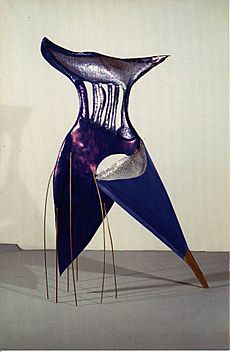Shelagh Cluett facts for kids
Shelagh Cluett (born December 17, 1947 – died July 25, 2007) was a talented artist and teacher. She worked in London, England, from the late 1960s until 2007. She became well-known in the art world in the early 1980s. Her large metal sculptures were shown all over the world. She also taught art at the Chelsea School of Art and Design for many years.
Contents
Shelagh Cluett's Early Life and Art Training
Shelagh Cluett was born in Bournemouth, England, on December 17, 1947. In 1968, she moved to London to study art at Hornsey College of Art. Later, in 1971, she continued her art studies at the Chelsea School of Art and Design.
Her First Artworks and Style
Shelagh Cluett's early art showed her interest in how the Earth is formed. This interest stayed with her throughout her career. Her first works looked like slices of landscapes. Soon, her art became more abstract, meaning it didn't look like real things.
Her sculptures were tall and had strong lines. They seemed to dance with curves and jumps. If you looked closely, you could see they were made from many different materials. She used wire, aluminum, wax, clay, wood, and tar. She layered these materials carefully to create a unique look. She also made smaller "thinking pieces" to try out new colors, shapes, and ideas.
Shelagh Cluett became a recognized artist in Britain. She had shows at the Ikon Gallery in 1979. Then, in 1980, her work was shown at Nicola Jacobs Gallery and ACME Gallery. After this, her art was shown widely in the UK and other countries. She also taught art at many different art schools. In 1980, she helped start the postgraduate sculpture course at Chelsea College of Art.
Art in the 1980s and 1990s

In the mid-1980s, Shelagh Cluett's art changed. She started to explore ideas from her travels in the Far East. These trips gave her new images and brighter colors for her sculptures. Colors became more important in her work. She put them on large, hammered metal surfaces, making her art shine and glisten.
Even though travel was important for her art, she had to fit it around her teaching. She was a main lecturer and head of the MA Sculpture course at Chelsea College of Art and Design. She showed her art in Britain and other countries like France, South Korea, India, and the United States.
Cluett became very interested in the spiritual and physical feelings of buildings. She called this the "sacred landscape" of architecture. She began to use computers to change temple plans. She shaped them to make the viewer feel connected to the building. Then, she would sandblast the plan onto a stone slab. This made the plan stand out against the rough stone. Cluett felt this created a special feeling in her art. The stone invited you closer, but the changed plan made you think, leaving you somewhere in between.
Using Digital Tools in Later Art
In her later works, like the Maps Without Territories Series (from the 1990s and early 2000s), she showed stone slabs with images from inside temples. She took these photos herself. They helped her capture a specific moment in the building's life.
Shelagh Cluett strongly believed that computers were important tools for artists. This showed in her own sculptures and in her teaching. She helped start FADE (Fine Art Digital Environment). This group helped students at Camberwell College of Arts and Chelsea with digital art. She also presented her work at many "digital art" conferences around the world.
Her Khajuraho Series (2002–03) was based on the Khajuraho temple complex. It was shown at the V&A in 2003. This exhibit, called Digital Responses, showed how Cluett combined digital images, video, and sculpture. This mix became a common part of her art.
She would put building plans over photos of sculpted figures, like tattoos. This was her way of connecting the bodies with the buildings and with each other. Cluett then used these "tattooed" figures in her next project. She wanted to find a hidden feeling in digital surfaces. The result was Under the Skin (2003), a film made using LCD screens and video. She used small errors that happened when zooming in and out of images on the screen. By layering these with other images, Cluett made a film with the depth she wanted.
Dead Ahead (2004) and Sea Fever (2005) were two digital projects. They built on what Cluett learned from Under the Skin. Cluett's ideas about the sea and coastline were very important to her. These projects showed the constant movement of the beach. She found that using the same image in different computer programs often mixed up the information. This created "incidents" on the surface, showing the image's visual history. She also realized that changing the speed of a video changed its sound. This gave her work an accidental soundtrack.
Cluett became interested in pixellation, which is when an image breaks down into small squares. This led her to study early mosaics, which are like an old form of pixellation. She visited ancient Roman sites like Pompeii and Ostia Antica. She took many pictures of mosaics and their surroundings. She used this material to make two new films, Ostia I and II (2006–07). She also made twisted digital images of mosaics. She planned to project these onto unusual surfaces to mix different art forms. Sadly, this project was not finished before she passed away.
Shelagh Cluett died in London on July 25, 2007, after battling a serious cancer.
The Shelagh Cluett Trust
The Shelagh Cluett Trust was created in her name. There is a large collection of her work that shows her career as a sculptor from the late 1960s until 2007.


